Chapter 38. Staying in Touch with RSS and Instant Messaging
In This Chapter:
- Learn what RSS is really all about
- Subscribe to RSS feeds from within Internet Explorer
- View your feed details
- Use Instant Messaging to stay in touch
One of the features that web users have now used and relied on for several years is RSS, which stands for Really Simple Syndication, as you learned in Chapter 9, “Working with the Sidebar and Gadgets.” Websites that support RSS make their content available to you and everyone else who has an RSS reader of some kind. The bottom-line advantage of RSS is that your favorite website’s content, if that site supports RSS, will come to you instead of you having to go to the website to see whether anything is new. Although you can use a Sidebar gadget to access RSS feeds, Internet Explorer’s RSS technology is simpler to use and puts your feeds where you’re most likely to want them: in your web browser.
After you set up RSS, you can stay in touch with websites. To stay in touch with people, you can use instant messaging (IM). Instant messaging gives you instant, online communication to others that use IM and to whom you want to chat when the two of you are online. IM isn’t specific to Windows Vista; any Windows version and any non-Windows operating system can use instant messaging. Instant messaging complements your online experience, and this chapter introduces you to IM technology in case you’ve been a hold-out and didn’t want to take the IM plunge before now.
All About Really Simple Syndication
As Chapter 9 explained, when you use RSS, you request that one or more websites send information to you. Internet Explorer offers a uniform RSS feed reader, and most people seem to like reading RSS feeds in IE as opposed to using the Sidebar and the RSS gadget.
In general, the RSS information sent to your computer comprise the newest entries on the site. For example, if you want to keep track of your favorite news site, and that website offers RSS support, you can subscribe to its RSS service.
By the Way
You don’t have to worry about personal information being sent when you subscribe to a site’s RSS feed. You don’t have to give any user information or create a password to grab RSS feeds; you let Internet Explorer know you want to subscribe to a site’s RSS feed and then IE takes over. It grabs those feeds and displays the RSS data when the site makes the data available.
When IE begins to grab RSS feeds from the RSS-based websites you’ve subscribed to, those feeds might come to your computer in small snippets and not full articles, or the full articles may appear depending on the RSS service available at that site. For example, if a news site supports RSS feeds and you subscribe to that news site, the RSS data that comes to you is often nothing more than the headline of each new article that appears on the site. The headline is a link to the page with the full article. In a way, an RSS feed is a synopsis of something more detailed that you can go to if you want to see more details.
Learning Whether a Site Supports RSS Feeds
If you want to know whether a site offers RSS subscriptions, visit that site and look at Internet Explorer’s toolbar. Your IE toolbar includes an orange RSS feed icon that is active if the site offers an RSS subscription and is grayed out if the site does not. Internet Explorer can retrieve different kinds of RSS feeds, including Atom feeds. Figure 38.1 shows the Address bar and toolbar areas of two Internet Explorer windows. The top IE window supports RSS feeds; its RSS icon is visible. The bottom IE window does not support RSS feeds because its RSS icon is grayed out. (In this book, you don’t see figure colors so the distinction won’t be as great here as it will be in your own browser.)
Figure 38.1. Internet Explorer’s own toolbar lets you know whether a site supports RSS subscriptions.

Subscribing to an RSS Feed
Before subscribing to a site’s RSS feed, you can usually click the active RSS button to see a web page that displays all current RSS feeds for the site. Figure 38.2 shows the FoxNews.com website’s RSS feed page that appears when you click IE’s RSS button while viewing www.FoxNews.com.
Figure 38.2. View the site’s recent RSS feeds.
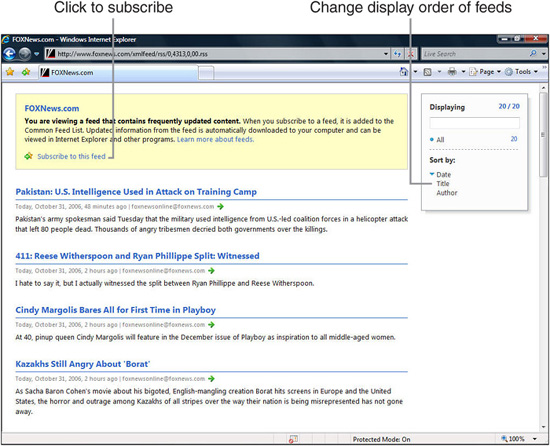
On the RSS page, you’ll see the headlines that appear in IE’s RSS reader area when you subscribe to that site. The feeds will be little more than linked headlines that take you to the more complete web content.
By the Way
You don’t have to view the web feeds for the site before subscribing; doing so, however, gives you an idea of the kinds of feeds that site provides.
If the feeds are the kind you want to subscribe to, click the plus sign next to the Subscribe to this Feed link and Internet Explorer begins grabbing data fed from that site. The Subscribe to This Feed box appears as shown in Figure 38.3. There you can type your own description for the feeds or keep the website’s address for the description. You can store the feeds in IE’s default Feeds folder or create a new folder by clicking the New Folder button and typing a new name.
Figure 38.3. Subscribe to the feed after deciding on a name and folder for the feed.
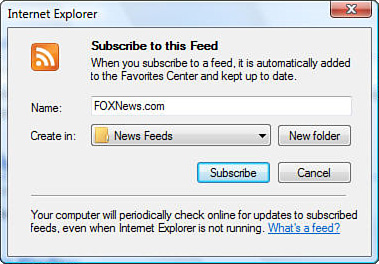
Did you Know?
If you subscribe to several feeds, you’ll want to organize them into folders by feed type. For example, you might want to store your news-related feeds in a folder named News and your entertainment-related website feeds in a folder named Entertainment. To narrow down to the feeds you’re interested in viewing at the time, you can expand or collapse the feed folders when you view all your feeds.
Click Subscribe to finish subscribing to a feed. At that moment, Internet Explorer begins to grab feeds from that site and stores them in your Feeds folder. If you opted to store the feed in a new folder, that folder appears as a subfolder under your regular Feeds folder.
Watch Out!
Some websites use an RSS feed that contains XML code called Document Type Definitions (DTDs) that Internet Explorer 7 doesn’t support at the time of this writing. The fact that IE doesn’t support that kind of feed might limit you from eventually grabbing feeds from certain websites. This means that either Microsoft will update IE to support DTD-based feeds or those websites that use DTD feeds will change to IE’s more universal, non-DTD feed type. Only time will tell. Microsoft is making an attempt to become more XML-centric, especially with Office 2007’s support for XML data, so it’s a surprise that Microsoft didn’t find a way to access DTD-based feeds.
When you use Internet Explorer to subscribe to an RSS feed, your Sidebar RSS Reader gadget also knows about that same feed. One alerts the other when you subscribe using one of those RSS feed readers and both track the same RSS feeds you subscribe under either program.
Viewing Your Feeds
To see your feeds, click to open your Favorites Center. There a Feeds button appears. When you click Feeds, your subscribed feeds appear in a list of individual site feeds and folders as shown in Figure 38.4.
Figure 38.4. IE gathers all your web feeds into one location where you can click for details you want to know more about.
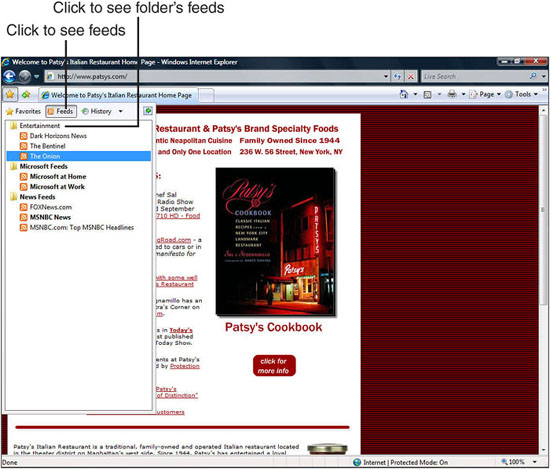
Hopefully you’re beginning to get the idea that RSS feeds can save you a tremendous amount of web-surfing time. In the past, you had to go check all the sites you’re interested in. You had to scour the site to see whether there was anything new and, if so, you would then read the new information. It was easy to miss something. It was time-consuming. You might have to check 15 to 25 sites each morning just to catch the new information in them.
Now, you can simply look at your RSS feed folders in Internet Explorer. Nothing that isn’t new will be listed for a given site. Quickly scan the new feeds, and click to read the ones you want to know more about.
Did you Know?
RSSfeeds.com (see Figure 38.5) and several other sites provide a list of hundreds of RSS-based websites, organized by subject. Use Google or another search engine to locate other RSS feed lists; they’re all over the Web.
Figure 38.5. RSSFeeds.com provides listings of many RSS-based sites you can subscribe to, organized by subject.
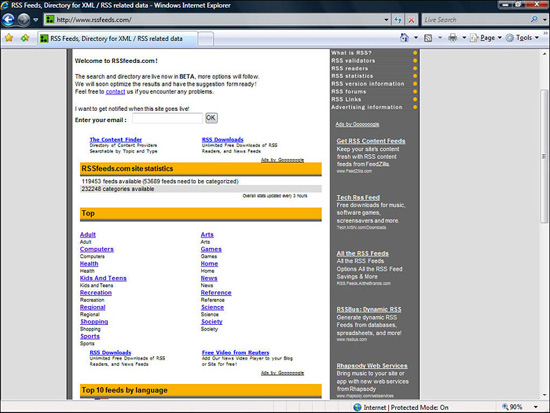
Did you Know?
Outlook 2007 was the first version of Outlook to support RSS feed subscriptions. You can view subscribed feeds in Outlook (see Figure 38.6) giving you three ways to view feeds using Microsoft-based products that are in common use: Vista’s gadgets, Internet Explorer 7, and Outlook 2007. If you want to view RSS feeds differently from the way that the Microsoft products display them, you can choose from several feed reading programs from websites such as www.BlogLines.com.
Figure 38.6. You can also view feeds in Outlook if you use version 2007 or later.
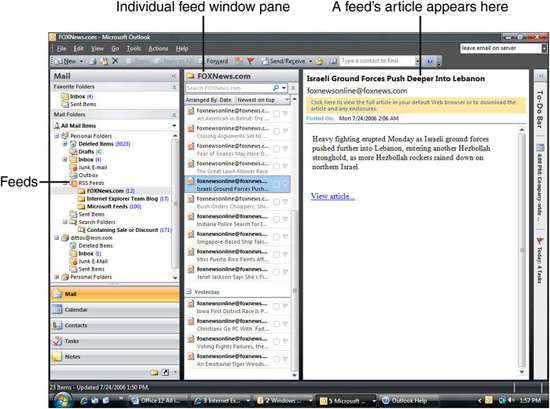
Watch Out!
You must be logged on to the Internet to receive RSS feeds. Dial-up users receive the feeds only when they connect to the Internet.
Managing Your RSS Feeds
Use Internet Explorer’s Favorites Center to manage your RSS feeds. You can move them around, rename them, and change which folders they appear in. In addition, you can completely delete an RSS feed from your subscribed list of feeds.
Click your Favorites button to open your Favorites Center. Click the Feeds button if your feeds are not showing. To move a feed from one location to another, even to a different folder, click and drag that feed to another location.
Use the right-click menu to rename or delete a feed. Figure 38.7 shows the right-click feed menu. Select Delete to remove a feed from your subscribed list. After IE confirms that you truly want to remove the feed, the feed goes away, you are unsubscribed, and all of that feed’s content that was available from your feed folders is deleted from your computer.
Figure 38.7. Right-click over any subscribed feed and select Delete to remove that feed from your list.
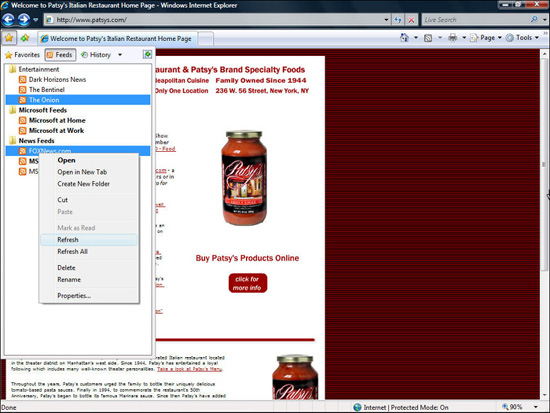
Instant Messaging Lets You Stay in Touch with Others Online
The first instant messaging programs used to provide users who were online at the same time a way to chat with each other. You typed back and forth and the online connection sent your messages back and forth.
Today’s versions of instant messaging programs do far more than send typed chat messages back and forth. Most support some kind of video and audio messaging service. Many support VoIP technology that allows you to use your Internet connection to make phone calls. Some even go so far as to allow you to take over someone else’s computer—when given permission to do so!—so that you can troubleshoot a problem a friend of yours might be having; you’ll see their screen in your instant messaging window and use your keyboard to control their machine until you solve the problem.
By the Way
Instant messaging is useful today even if none of your friends or associates are online at the same time you are. IM programs often serve up news, weather, and other information while you’re online, alerting you to different events you’ve requested such as new emails arriving and can even tell you when you win an eBay auction.
For the first time in years, Microsoft chose not to include an instant messaging program in Windows Vista. This is most strange considering instant messaging is more popular than ever before.
Recent versions of Windows included Microsoft’s own Messenger. Microsoft Messenger has had several names through the years including Windows Messenger, MSN Messenger, and the current iteration, Windows Live Messenger. If you have a Microsoft Passport, Microsoft Live ID, or use Hotmail, MSN, or live.com for email, you can download and use Microsoft’s Messenger program.
Yahoo! and AOL have their own competing instant messaging programs. Until recently, they didn’t talk well to one another, so if you wanted to communicate with an AOL user but you used Yahoo! Messenger, you had to install AOL’s messenger as well or send an email. As time goes by, companies that provide IM programs are relaxing their protocols to allow other services to communicate with them. The current Windows Live Messenger can chat back and forth with Yahoo! Messenger and perhaps more instant messaging services will be available to use with Windows Live Messenger by the time you read this.
Installing Your Instant Messaging Program
Because Vista doesn’t come with an IM program, you must find your own.
The following steps explain how to locate and install Microsoft’s Live Messenger. If you use a different IM service, that’s fine. If you don’t yet use an IM but want to try, Microsoft’s works well and has a good feature set. In addition, Microsoft’s is sure to work with your Windows Vista operating system. Probably the other IM programs (sometimes called IM clients) will also work under Vista, but Microsoft certainly has the most to gain by making Microsoft Live Messenger fully compatible and respectful of Vista so that’s the one described here.
To install Windows Live Messenger, go to the http://get.live.com/messenger/overview web page shown in Figure 38.8. Click the Get It Free button to begin downloading the Windows Live Messenger program.
Figure 38.8. Vista doesn’t come with an IM program, so you must locate and download one yourself.
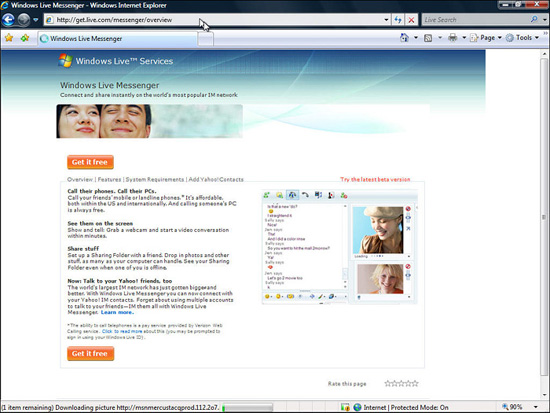
IE offers to run or save the downloaded file. In case you need to reinstall Windows Live Messenger in the future, click Save and create a folder for Windows Live Messenger in your Downloads folder. This makes installing Windows Live Messenger on other computers in your home or business faster because after you save it on your disk, you can copy the downloaded installation file to a CD or USB flash drive and install on all your other computers without waiting for the download again. When the file downloads to your folder, click Open to run the installation program and follow the prompts.
During installation, you must agree to the typical, wordy, cloudy legal agreement. In addition, Windows Live Messenger offers, in a dialog box like the one shown in Figure 38.9, to make all sorts of changes to your system. Unless you live and breathe instant messaging, the settings and programs Windows Live Messenger offers to set up for you can be intrusive. For example, do you want your home page changed to MSN.com?
Figure 38.9. Windows Live Messenger offers to change several items on your computer; unselecting these options before continuing might save you from having to reverse their effects later.
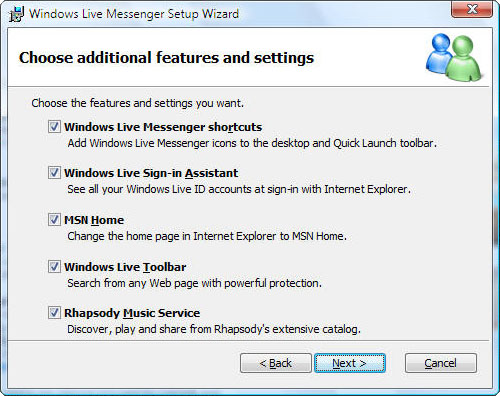
Did you Know?
Keeping the option labeled Windows Live Sign-In Assistant might be the only one most users should consider leaving checked. If you get additional Windows Live Messenger accounts (they are free), checking this option enables Windows Live Messenger to sign you on to all your accounts to check email and messages in each one from the same Windows Live Messenger window.
After clicking to uncheck any or all Windows Live Messenger’s suggested options, click Next to continue with the installation. Windows Live Messenger has to verify your administrative privileges during the installation and Windows Live Messenger will finish installing. When the installation finishes, Windows Live Messenger opens in its own window, as shown in Figure 38.10.
Figure 38.10. You have to tell Windows Live Messenger your email address and password to use instant messaging and other features.
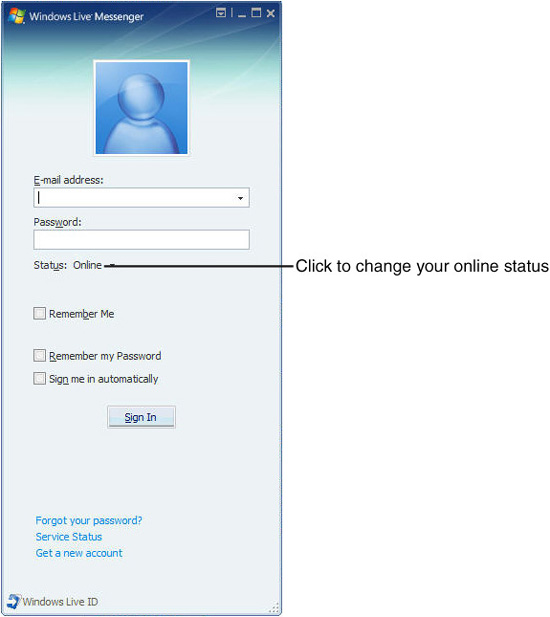
Type your Windows Live Messenger email address and password in the boxes provided. Remember, these are from your Hotmail or MSN email account, or perhaps your MSN Passport or Windows Live ID. Click Remember Me if you want Windows Live Messenger to remember your email name, and click Remember My Password if you want Windows Live Messenger to remember your password so that you don’t later have to enter your username or password. Click the option labeled Sign Me In Automatically if you want Windows Live Messenger to sign you on every time you log in to your user account. Click Sign In to log in to Windows Live Messenger.
Did you Know?
When you sign in to Windows Live Messenger, others who have added you as a contact to their Windows Live Messenger system can see that you just signed on because they can set their IM to notify them when friends and family sign in. This means that you might get lots of instant messages the moment you sign in to Windows Live Messenger. It’s great to have friends, but sometimes you need to get some work done. Click the arrow to the right of the Online status and change your status to Busy or Away, Be Right Back, Out to Lunch, In a Call, or Appear Offline if you don’t want it made known to everyone who has you as a contact in their IM programs that you just signed in. You can easily change your online status to Online whenever you’re ready to chat by right-clicking the Windows Live Messenger Notification Area icon on your taskbar and requesting the status change.
If you’ve used Windows Live Messenger on other computers, your newly installed Windows Live Messenger knows all your contacts, so you don’t have to start from scratch every time you install Windows Live Messenger on a new computer.
By the Way
If you use Windows Firewall, you might see a warning that it blocks some of Windows Live Messenger’s features, as shown in Figure 38.11. As long as you don’t mind allowing all of Windows Live Messenger’s features to work without dampening any of them, click the Unblock button, confirm your administrative privileges, and Vista gives Windows Live Messenger full access.
Figure 38.11. Let Windows Vista’s firewall know that Windows Live Messenger is a program you want to give full access to; otherwise, some features such as being able to share files over your own network might be blocked.
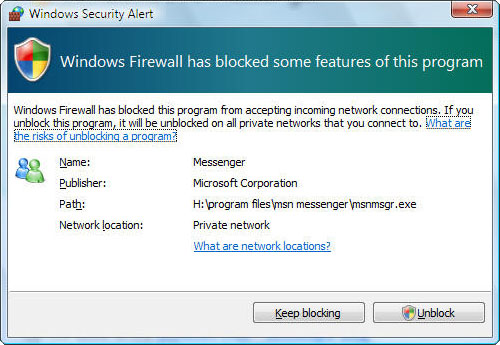
If you get a question asking whether you want to add sharing folders on your computer, it’s usually okay to allow them unless you have high security concerns and you share a computer with others who might gain access to your Windows Live Messenger account if you walk away and forget to log off your user account. By allowing shared folders, you can share files such as pictures and videos with others who use Windows Live Messenger and Yahoo! Messenger, and who you’ve added to your Windows Live Messenger contacts list and who have given you access to theirs.
Adding Contacts
Even though today’s IM programs provide far more than keyboard-based chat sessions, such online chats are still the most popular use for IM programs. People from all over the world can chat by typing messages back and forth with each other as long as both log on to the Internet and their IM programs at the same time.
In my home, we use Windows Live Messenger constantly. We have one computer upstairs and another downstairs, and it’s too far to talk to each other and we’d get hoarse yelling. Therefore, when two of us are on, we can easily send an instant message to each other, telling that dinner is ready or perhaps asking whether the mail has arrived. When we travel separately, we can be in different states but if we’re both logged in to Windows Live Messenger, we chat by typing messages and the response time seems to be identical to the response time (virtually instant) when we’re in the same house. About once a week, an Italian friend of my wife’s who lives in Messina, Italy sees Jayne sign in and sends a Ciao! (Hi!) message and chats for a few moments. We would miss IM if we lost the ability to use it, and if you give it a chance, you will like it too. You’ll find new ways to use it all the time.
By the Way
Unlike most text messaging sent over cell phones, IM messages don’t cost money to send. You can, by the way, send a cell phone a text message from most IM and email programs; the cell phone provider can supply the email address to use.
To chat with someone, you need to add that person to your IM’s contacts list. To do this in Windows Live Messenger, click the Add a Contact button to display the Add a Contact dialog box shown in Figure 38.12, and fill in as many details as you can. The email address is required. Click Type A Personal Invitation if you don’t want to use the standard IM invite that Windows Live Messenger sends requesting that your contact add you to their contacts list if you’re not there already. (Both of you must accept the other as a contact before you can chat.)
Figure 38.12. Let Windows Live Messenger know the contact’s email address you want to invite to be a chat buddy.
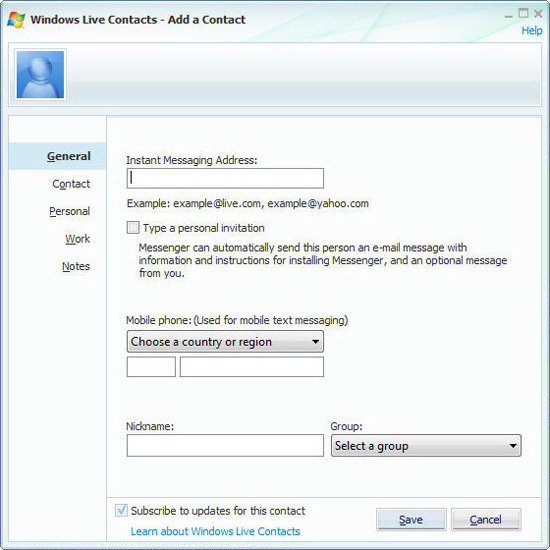
As you can see in Figure 38.12, you enter your contact’s text messaging number in this Add a Contact window when you want to be able to send instant messages to their cell phones. Be warned though, this might cost your contacts a dime or so for each message you send, depending on the cell phone plan they have.
The Nickname and Group entries allow you to give your contact a nickname and assign that person to one of three groups: Coworkers, Family, Friends. By grouping your contacts properly, you can more easily locate people you want to chat with as your contacts list grows.
Talking to Others
To chat with one of your contacts, that contact must have approved your invitation to be one of your contacts. After the person does that, you can chat. When that contact signs in to Windows Live Messenger, you’ll see a pop-up box like the one shown in Figure 38.13 telling you that person is online. You can click the name in the pop-up box or right-click the contact in your Windows Live Messenger window and select Send an Instant Message to open a message window and chat.
Figure 38.13. When one of your contacts comes online, Windows Live Messenger tells you; click their name to chat.
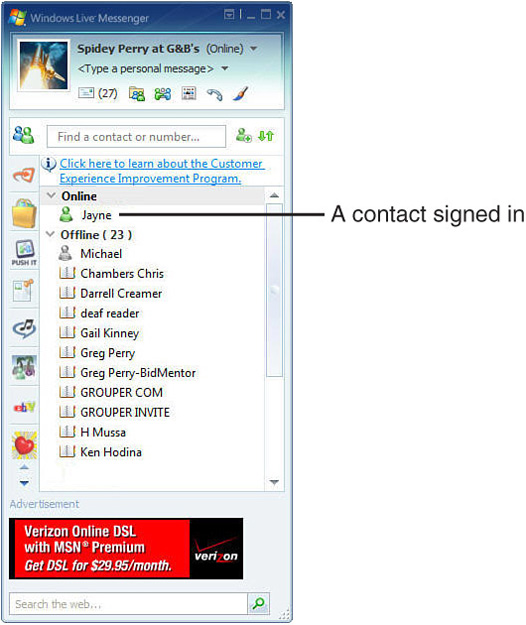
By the Way
You’ll soon notice that Windows Live Messenger opens two windows when you sign on: a Windows Live Messenger window with your contacts and a Today window that displays some news headlines, entertainment information, and a bunch of ads. You can keep the Today window from opening every time you sign in to Windows Live Messenger by clicking your name at the top of the smaller Windows Live Messenger window and selecting Personal Settings. Click the General tab and click to uncheck the Show Windows Live Today After signing in to Messenger option. The Today window won’t automatically appear the next time you sign in to Windows Live Messenger.
After you request a chat with one of your contacts, the chat window opens. The top of the window shows your complete chat session as each of you types messages back and forth to one another. The lower text box is where you type messages to your chat contact.
Figure 38.14 shows a chat session taking place. To send a message, type in the lower text box and press Enter or click Send. Your contact sees your message and can reply the same way. In Figure 38.14, the chat goes back and forth in real time as each person types messages to the other. You’ll also see two emoticons, icons that portray emotion, one being a happy face licking his lips after the food reference. In the past, you indicated an emoticon with a symbol such as:) to represent a happy face; those symbol-based emoticons are read sideways, but if you type such a symbol, Windows Live Messenger turns it into an actual colorful icon.
Figure 38.14. Send messages back and forth and include emoticons for an extra-special effect.
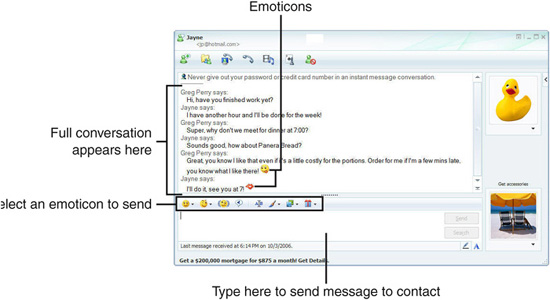
Instead of knowing which symbols produce which emoticons, you can click the Select an Emoticon drop-down icon and choose from several that Windows Live Messenger makes available.
Did you Know?
Play around with the symbols and options on the message window. You can send a wink or a nudge to your Windows Live Messenger contact. A wink makes a large icon move and appear on your contact’s screen (they’re funny), and a nudge completely shakes your contact’s IM window and makes a buzzing sound in case you suspect your contact didn’t notice that you just sent an instant message. Other tools are available to format your text, change the picture that appears when you chat, and place a background image on your IM chat session to make the experience more pleasant.
Additional IM Options
If you’re in the middle of a chat and want to invite a third contact into the chat, click the Invite Someone to This Conversation button in the upper-left corner of your chat session’s toolbar. As long as that person is online and is a contact of one or both of you in the current conversation, you can add that person and more to join in.
It’s simple to send files back and forth and often gets around email spam filters and file size limits that still plague email. Click the Share Files button on the instant message’s toolbar, select Open Your Sharing Folder to select files from your shared folder or select Send a Single File if you want to send a file that’s not in a shared folder or if you don’t yet have shared folders set up. After you select a file, Windows Live Messenger sends it to your contact’s computer.
Did you Know?
If one of you does not have shared folders set up, you can set up shared folders from the Personal Settings window. The shared folders are simpler to access from Windows Live Messenger, but make sure that you make available only files you want to share with any or all of your contacts. When you open a shared folder and are online with a contact, that contact can see all files you store there and can download any or all of them.
If you want to hold a video conversation with your contact, click the chat toolbar’s Start or Stop a Video Call. The first time you select this option, Windows Live Messenger presents you with the Audio and Video Setup window shown in Figure 38.15. Generally this ensures that both of you have a webcam connected to your computer so that the other can watch you and you can watch them as you talk. As you might expect, the quality and speed of the video isn’t bad but certainly isn’t broadcast quality; nevertheless, being able to hold video-based conversations with any contact in the world, without incurring a charge, is an amazing testament to instant messaging.
Figure 38.15. You have to set up your audio and video equipment before having a video-based conversation with a contact.

You can even play games with your contacts. Click your toolbar’s Games button and select a game to play. Windows Live Messenger connects to the Internet and downloads the game to both your computers, and you are playing in no time. If you’re playing chess, for example, you’ll both make moves and see your opponent’s moves in real time.
By the Way
When you send a file or offer to play a game with a contact, Windows Live Messenger sends a request to your contact that your contact can accept or reject.
The first time you end a conversation with someone, Windows Live Messenger displays the Windows Live Messenger dialog box shown in Figure 38.16. Your response to this dialog box determines whether you want Vista to keep a transcript of your online chats. By selecting Yes, you inform Vista that you might want to read the transcript of a keyboard chat session you have had in the past. As long as you’re okay with that, save the transcript. If you see no reason to save or if you want the privacy (as you might if you’re, say, a politician), don’t save copies of your chat sessions.
Figure 38.16. Tell Windows Live Messenger whether to save transcripts of your instant messages.
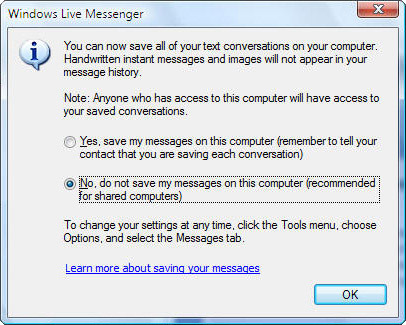
When you finish a chat, the Windows Live Messenger window remains on your screen although you can close this window and remain online with Windows Live Messenger. Closing the window gets rid of it from your screen, but your taskbar’s notification area still displays the instant message icon that you can right-click to start a chat or view email (for the web-based email system connected to the chat such as Hotmail). Double-click the Windows Live Messenger icon to open your Windows Live Messenger window again in case you need to set some Windows Live Messenger options or talk with someone using that interface.
Did you Know?
Along the left edge of the Windows Live Messenger window appears a list of icons that you can scroll through. You’ll find an eBay icon that displays a subset of eBay.com that you can search through for something to buy. Click the Rhapsody icon to see the Rhapsody music website from which you can purchase and download music to your computer. Other icons represent financial and news websites as well as offer activities that might interest you as a Windows Live Messenger user.
Viruses and spyware can infect instant messaging programs, and some people send out blanket contact requests using randomly generated IM addresses hoping you respond to a request. As with email, use care. These kinds of problems aren’t as common as they are with email, and a good antivirus and spyware protection program that you update regularly should keep you from any problems.
Chapter Wrap-Up
This chapter explored ways you can keep touch with websites (RSS feeds) and ways you can keep in touch with friends and family (instant messaging) while online.
By using RSS feeds, you take control of when you want to view content without running the risk of missing content. The summaries go to your Favorites Center’s Feeds folders regularly and await your attention there. You don’t have to browse through all the websites you normally peruse to see new updates to those sites.
Communicate instantly with friends by downloading and installing an instant-messaging program. You can send keyboarded instant messages back and forth or even communicate by video and voice, free of charge, to others in your contacts list. IM is a way for anyone online to chat with anyone else in real time and demonstrates the true power of today’s wired world.
This and the previous chapter explored ways that you and your computer keep in touch with others over the Internet. Sometimes you want your computer to keep in touch with other devices, such as your cell phone and PDA (personal data assistant). Synchronizing such devices with some of your pertinent computer files keeps your needed data with you when you’re on the go.
